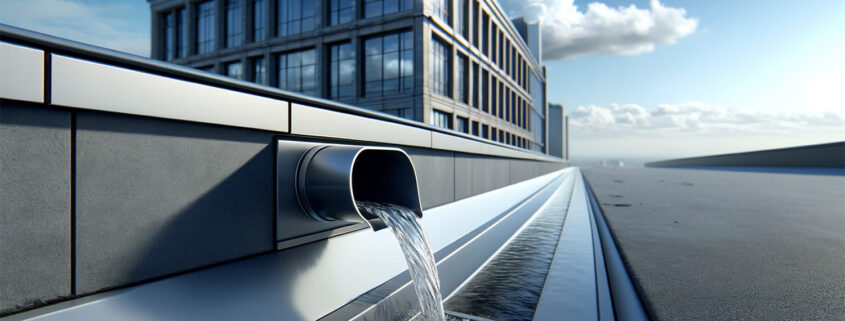Unless you have a rooftop garden, you probably don’t want water anywhere near your roof. To ensure the longevity of commercial roofing, proper drainage is crucial, because ponding water can do serious damage to the integrity of the roof membrane.
Preventing buildup needs to be a priority, so having the right roof drainage system is imperative.
Flat roof drainage systems differ from pitched/sloped roof systems because flat roofs can’t utilize gravity to remove water from the roof. A pitched roof can suffice with only gutters; flat roofs often need a completely different system.
Types of Drainage Systems
Depending on the layout of your roof surface and the region in which you’re located, some drain systems work better than others.
Roof drains need to be the right fit. If not, drainage is less effective and raises your risk of a roof leak or water damage.
Here are the three most popular types of drainage systems for commercial roofs.
Scupper Drainage
Located near the edge of your flat or low-sloped roof, scuppers allow water to drain directly off the side of the building or into downspouts and gutters, removing water from the surface. (Scuppers are basically an opening in the parapet wall of your roof, and are extremely common in commercial roofing.)
They’re pretty simple in regard to drainage options for a flat roof drain, and can work for different types of flat roofs. Effective for both regular water flow as well as overflow, larger scuppers rarely clog and require less regular maintenance than other options.
As one of the most affordable drainage options, it is no wonder that many roofing contractors opt to use scuppers in favor of other types of drains.
Keep This In Mind
While larger scuppers rarely have issues, smaller scuppers can encounter obstacles. Smaller scuppers clog more easily, and these blockages can lead to water pooling on your roof. Also, if the scuppers are not connected to a downspout or gutter, water flowing off the edge of the roof can cause issues with the building’s foundation (or seep into the building).
Siphonic Drainage
A Siphonic drainage system prevents air from entering the downpipes. Most gravity drainage systems cause a whirlpool effect that allows air into the system, resulting in water pushing to the sides of the pipes (which reduces the amount of water that can be drained), leading to more wear and tear over time.
Siphonic drain system outlets, by comparison, have a baffle plate, which serves as a strainer that removes air instead of solid matter. The strainer also creates negative pressure inside the pipes, which disposes water more efficiently than gravity alone.
With low levels of rain, the difference between a siphonic system and a standard gravity system is negligible. It is during heavy rain that the benefits begin to show. When there is excess water, the baffle only allows water into the system, which stops a whirlpool effect from occurring.
Considerations for Siphonic Drains
The main disadvantage of siphonic drain systems is that, due to the decrease in required pipe size, they clog more easily than other systems, meaning more frequent maintenance is needed to avoid blockages. Get your building properly inspected by an expert before installing a siphonic drainage system. (Make sure your building is well-suited for one!)
Gutter System
Now, let’s talk about a gutter system as an option for a flat roof drainage system. While better suited for pitched/sloped roofs, flat roofs can still use gutters effectively if they have a pitch that allows water to flow.
When using a gutter system for a flat roof, it’s important to purposefully direct water toward a specific side of the building where gutters are located. Gutters are easy to install and can be modified without much hassle, making them an appealing option for many. However, not all flat roofs are suitable for gutters, so talk to a roofing professional to make sure they’re a viable option.
Why Additional Consideration is Needed
The main issue with gutters, besides the potential for lacking compatibility with your building, is that they require periodic inspections, cleaning, and can often need repairs due to lower durability. That said, if you are in a climate that does not get heavy rain, gutters can last for longer.
Do You Need Help With Roof Drainage?
Standing water is a detriment to the health of your roof – there’s no way around it.
But, you can drain water effectively with the most efficient system. Whether you wind up needing interior drains, gutters, scutters, or another type of drainage option, be sure to call a roofing professional to find the right fit. Avoid structural damage!
Look no further than TEMA Roofing Services. We handle any commercial roofing need: 24-hour emergency roof repair, installation, inspection, and much more. Contact us today to get a quote!




